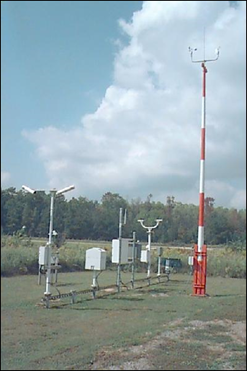April 26, 2021 - Thousands of amateur meteorologists across the United States help the National Weather Service track weather patterns by performing a daily task - checking the temperature and precipitation amounts on their property. These citizen scientists record and report their findings to the agency, every day.
Daily temperature and precipitation observations collected by volunteer cooperative observers and Automated Surface Observing Systems are used by NOAA scientists to develop the 30-year average of weather and climate data, known as Climate Normals, set to update on May 4.
"Forecasts are for today, observations are forever," said National Weather Service Director Louis W. Uccellini, Ph.D. "Thanks to all of our cooperative observers. Your work is key to sustaining the climate record as we compute the average temperatures over the last 30 year period."
The National Weather Service Cooperative Observer Program, launched in 1890, is a network of over 10,000 volunteers gathering observations at roughly 8,100 weather stations located on farms, in urban and suburban areas, in National Parks, and on seashores and mountaintops. There are observers in every state and U.S. territory from Palau to Puerto Rico.
"The century-long accumulation of weather observations taken by volunteer observers provide a baseline to compare yesterday’s weather and tomorrow’s forecast and establish record amounts," said National Cooperative Observer Program Manager Amy Fritz. “The climate normals dataset are critical to several weather-related functions and help inform activities in many economic sectors such as agricultural, energy and travel."
Farmers and pilots were early adopters to the importance of weather observations
 |
| The National Weather Service uses the Automated Surface Observing Systems for gathering surface weather observations. Credit: NOAA |
Farmers know crop growth success is closely related to the weather. Monitoring local climate was and is a constant for them. In the early 1900’s, many farmers felt it their duty to the country to record and provide valuable weather data to the National Weather Service. Many cooperative observer weather stations have been passed down in families for generations. For 165 years, the Maddox Family from Rome, Georgia has provided the longest continuous record by a cooperative observer. As for farming locations, the Wright Family of Redrock, New Mexico, has been taking observations from their 320 acre farm for multiple generations.
In 1926, the Air Commerce Act directed the National Weather Service to provide weather services to civilian aviation, so pilots would have information they needed to fly safely. This led the way for gathering weather observations at airports. Today, airports across the country have Automated Surface Observing Systems - instead of taking manual observations - gathering weather data to support airport operations and provide input for the climate record.
More than 900 ASOS stations in the U.S. have been in continuous service for almost 30 years. Providing observations every minute of every hour of every day, each station includes sensors to measure wind speed and direction, dew point, air temperature, precipitation type and amount, visibility, cloud height and thickness, and station pressure.
Assuring accuracy of local surface temperatures and precipitation is a challenging and evolving undertaking. Daily reports from the Cooperative Observer Program along with data from Automated Surface Observing Systems are quality controlled first by National Weather Service meteorologists then by a comprehensive sequence of automated computer procedures at NOAA’s National Centers for Environmental Information (NCEI). In some cases, additional manual quality assessments are performed at NCEI.
“If NOAA says a record temperature was set, you can trust that record," said Fritz.